هل تعلم أن هناك شركة نرويجية ناشئة صغيرة على وشك إطلاق أسرع عملية الكشف عن أضرار السيارات في التاريخ بحلول وقت نشر هذا المقال؟
في المتوسط، تستغرق هذه العملية 15 دقيقة في المتوسط، ولكن بفضل تقنية الذكاء الاصطناعي وأتمتة العمليات التجارية (BPA), وين تمكنوا من تقليل هذا الرقم إلى 6 ثوانٍ - أي أقل بنسبة 99.33% من معيار الصناعة الحالي.
في حين أن الأمر قد يبدو وكأنه شيء من أفلام الخيال العلمي، إلا أن مثل هذه التعطيلات أصبحت شائعة بفضل أتمتة عمليات الأعمال (BPA).
ومع ذلك، فإن العلاقة بين الأتمتة والعمليات التجارية ليست واضحة دائمًا، وإحدى أفضل الطرق لفهمها هي النظر إلى الأمثلة، وهو بالضبط ما سنفعله في هذه المقالة. ستشاهد أمثلة واقعية لأتمتة عمليات الأعمال مدعومة بـ أدوات إدارة عمليات الأعمال التي يمكن لأي شخص نشرها في دقائق.
والآن، دعونا نعرّف أتمتة عمليات الأعمال حتى نكون جميعًا على نفس الصفحة قبل الغوص في الأمثلة!
ما هي أتمتة العمليات التجارية؟
بعبارات عامة، تشير أتمتة العمليات التجارية (BPA) إلى استخدام التكنولوجيا لأتمتة و تبسيط العمليات التجارية من أجل زيادة الكفاءة التشغيلية، وتقليل الأخطاء البشرية والتكاليف، وتحسين الإنتاجية الإجمالية.
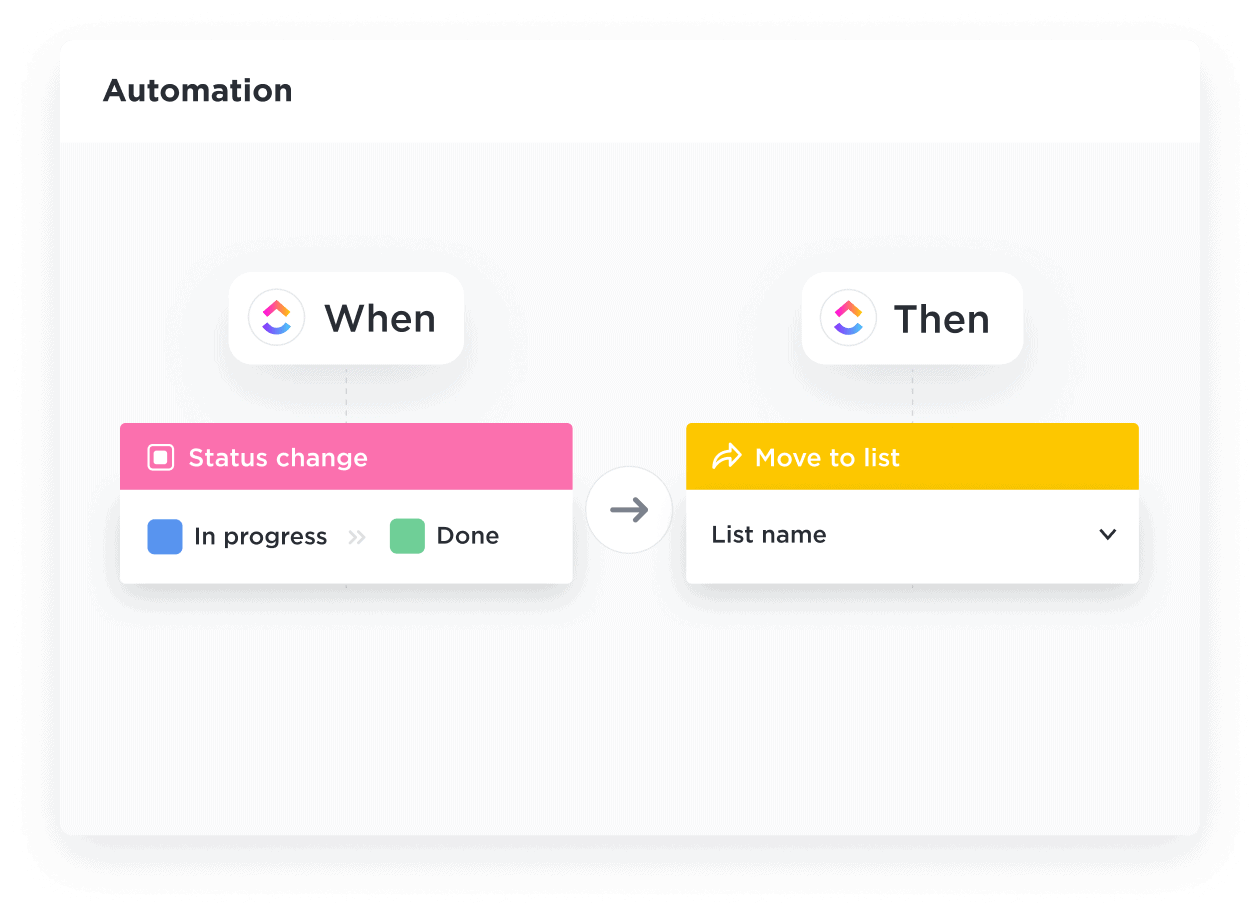
قم بإنشاء وصفات أتمتة مخصصة أو استخدام وصفات أتمتة مسبقة الإنشاء لأتمتة العمل الروتيني وتبسيط سير العمل المعقد
بشكل عام، الهدف الأساسي من BPA هو الكفاءة. ⚡️
BPA عبارة عن جهد مخطط وعالي المستوى لأتمتة المهام اليدوية المتعددة داخل عملية لتحسين الإنتاجية والكفاءة . هذا هو نجم الشمال في كل استراتيجية لأتمتة عمليات الأعمال التجارية، وهو المحرك الرئيسي وراء كل الجهود المبذولة لأتمتة العمليات في جميع الأعمال.
كيف تساعد أتمتة عمليات الأعمال المؤسسات؟
من خلال تحسين كفاءة العمليات التجارية، تزيد أتمتة العمليات التجارية من الإنتاجية، وتقلل التكاليف، وتسمح للأشخاص بالتركيز على الأنشطة عالية القيمة التي تتطلب خبرة وإبداعًا بشريًا.
وهذا يترجم إلى فوائد متعددة، مثل:
- تقليلالتكاليف التشغيلية
- اعتماد أقل على الموارد البشرية كثيفة رأس المال
- قابلية توسع العملية
- أخطاء أقل من الإدخالات اليدوية
- خدمة عملاء أفضل
- تبسيط العمليات التجارية
- والمزيد
علاوةً على هذه الفوائد الملموسة والقابلة للقياس، يمكن أن يحسّن نظام BPA من رضا الموظفين من خلال إزالة المهام الأكثر تكرارًا من أيديهم وتركهم يتحملون مسؤوليات تتطلب التفكير النقدي والإبداع ومهارات حل المشكلات.
وبشكلٍ عام، فإن فوائد BPA واضحة وضوح الشمس: مساعدة المؤسسات على تحقيق قدر أكبر من الكفاءة والدقة والاتساق في عملياتها مع تقليل التكاليف وتحسين رضا العملاء والموظفين.
نصيحة يُعد تخطيط العمليات عنصرًا حاسمًا في تنفيذ تدفقات العمل والعمليات التجارية الفعالة. استخدم أدوات موثوقة وعالية الأداء أدوات تخطيط العمليات و قالب مخطط تدفق العمليات بواسطة ClickUp لإنشاء تمثيل مرئي لعملياتك. يمكن أن يساعدك إنشاء مخطط انسيابي مفصل قبل إعداد الأتمتة في ضمان سلاسة العملية وخلوها من الأخطاء.
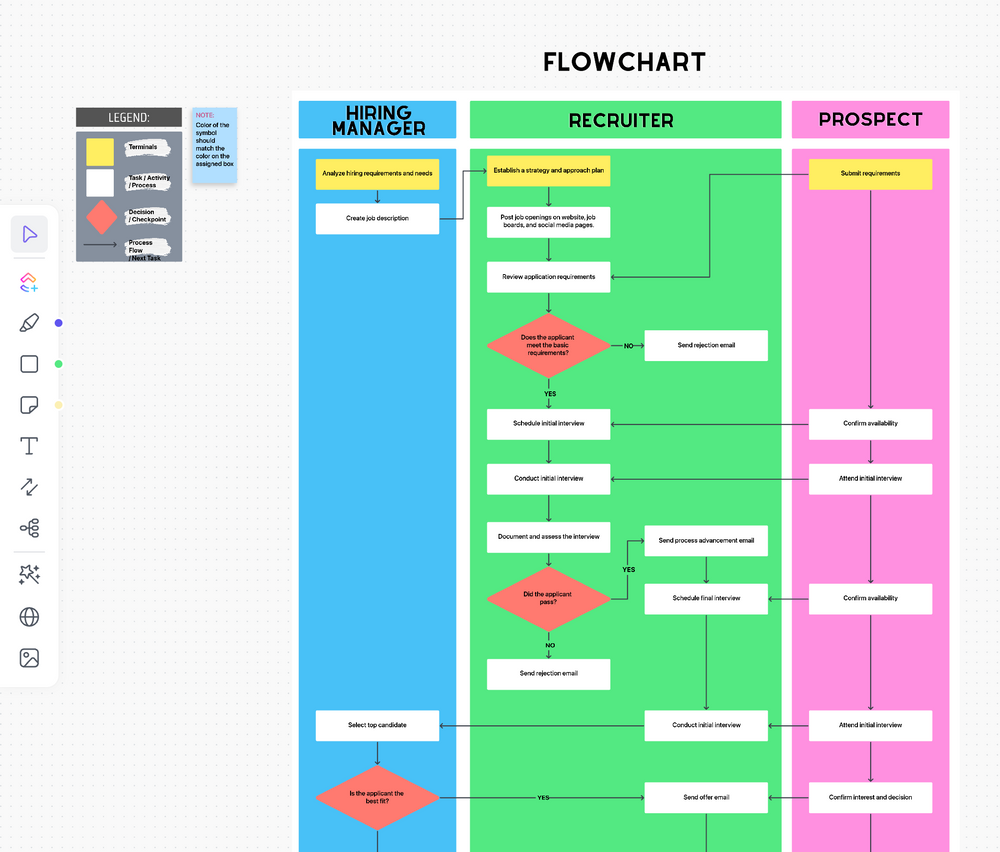
استخدم قالب مخطط تدفق العمليات من ClickUp لتخطيط عملياتك وتخصيص القالب ليناسب احتياجاتك
هل تتضمن BPA حلول برمجية؟
الإجابة هي نعم. تتم أتمتة العمليات التجارية في الغالب باستخدام منتجات برمجية مخصصة أو تعليمات برمجية مخصصة، وعادةً ما تكون مزيجًا من الاثنين معًا وليس حصريًا.
يمكن أن تتضمن برمجيات أتمتة العمليات التجارية مجموعة متنوعة من التقنيات، بما في ذلك التعليمات البرمجية، وأتمتة العمليات الروبوتية (RPA)، وأتمتة سير العمل المستندة إلى السحابة، والتعلم الآلي، والذكاء الاصطناعي، ومعالجة اللغات الطبيعية.
بالإضافة إلى ذلك، يمكن استخدام أكثر من أداة واحدة لأتمتة العمليات التجارية في نفس الوقت. على سبيل المثال، قد تستخدم شركة ما أدوات الأتمتة الآلية للعمليات لأتمتة العمليات التي تتضمن تطبيقات قديمة أو مستضافة ذاتيًا، ثم تستخدم مجموعة أخرى من الأدوات لأتمتة العمليات وسير العمل التي تتضمن تطبيقات قائمة على السحابة أو واجهات برمجة التطبيقات الداخلية.
تشمل الأدوات والبرامج التي تسمح للشركات بأتمتة العمليات التجارية ما يلي ClickUp و اصنع ، خاصة إذا كانت حزمة تطبيقاتك مستندة إلى السحابة، ولكن هناك عمليات تجارية أخرى برامج الأتمتة كما يمكنك التفكير في ذلك اعتمادًا على احتياجاتك والتطبيقات التي تستخدمها والعمليات القائمة.
نصيحة للمحترفين إن انقر فوق وإجراء التكامل يمكن أن يوفر لك الوقت وأتمتة أي عمليات بين ClickUp وتطبيقات العمل الأخرى - لا حاجة إلى مهارات تقنية. عندما تستخدم ClickUp كبرنامج BPA وتربطه بـ Make، ستتمكن من تصميم وإنشاء وأتمتة مهام سير العمل البسيطة إلى المعقدة لتبسيط عملك. ما عليك سوى تعيين المشغّلات والشروط لأتمتة مئات الإجراءات، واستخدام قوالب مُعدَّة مسبقًا لمساعدتك على البدء على الفور.
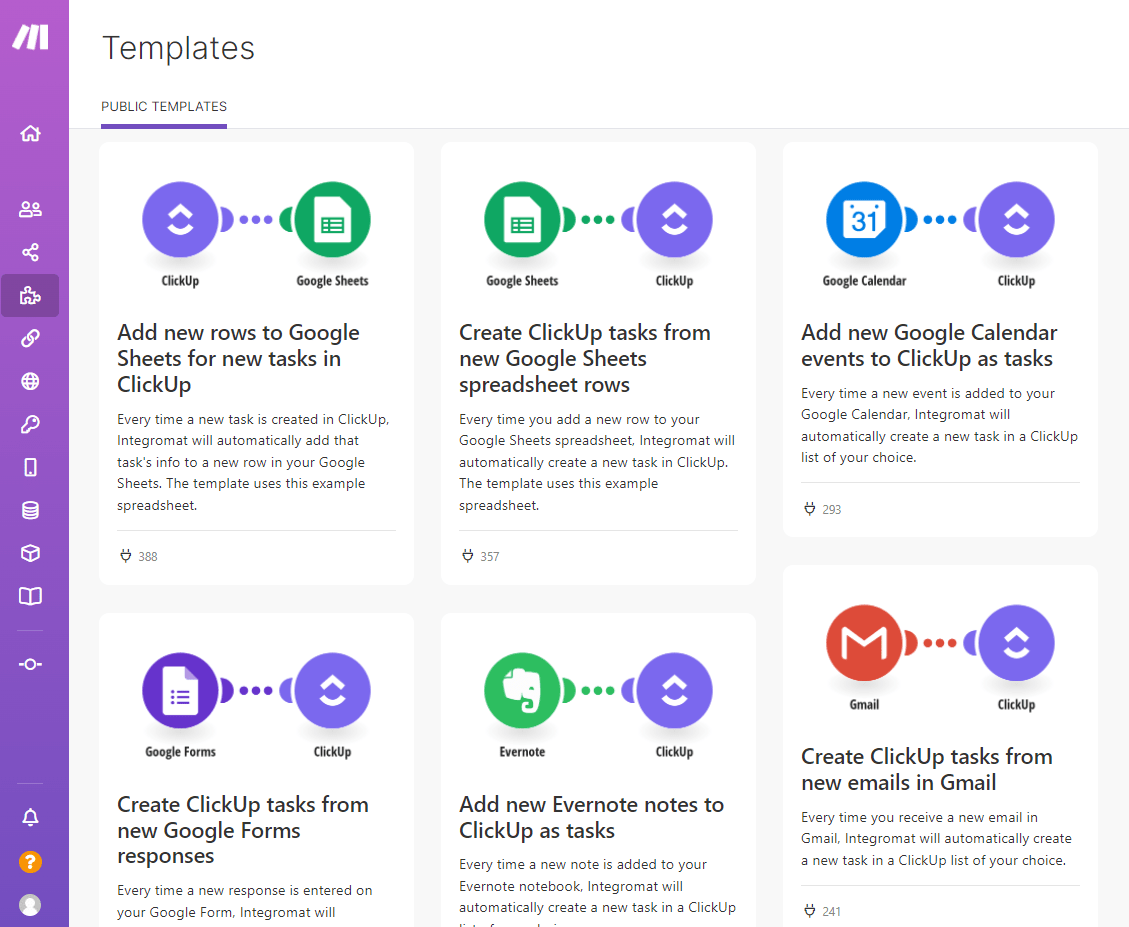
استخدم قوالب الأتمتة المبنية مسبقًا وأنشئ تكاملاً مخصصًا مع Make و ClickUp
ما نوع العمليات التي تندرج ضمن فئة BPA؟
من المهم ملاحظة أن BPA يغطي العديد من الأنشطة، بدءًا من العمليات اليدوية اليومية إدخال البيانات إلى أتمتة العمليات وسير العمل والمهام بأكملها. يكمن الفرق بينهما في مدى التعقيد وعدد المهام أو الخطوات والمهام الفرعية المعنية.
على سبيل المثال، يمكن أن تتوخى استراتيجية BPA الخاصة بك أتمتة عملية توظيف المرشحين بالكامل أو تأهيل الموظفين. قد تتضمن هذه العملية سير عمل ومهام محددة أيضاً. ومن الأمثلة على سير العمل ضمن تلك العملية تنسيق عملية المقابلة مع المرشحين وجدولة الدورات التدريبية.
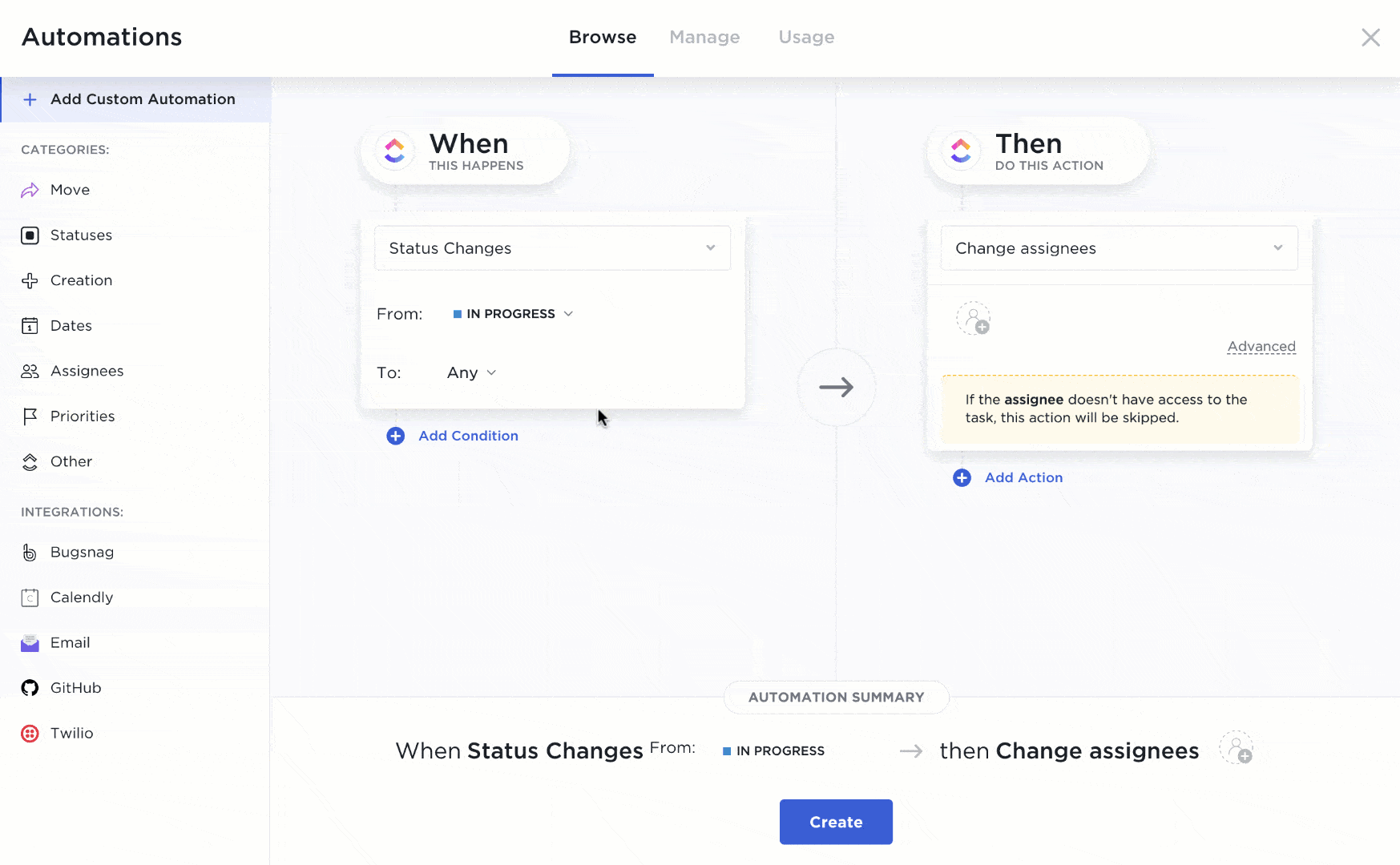
استخدم وصفات الأتمتة المُنشأة مسبقًا في ClickUp أو قم بتخصيصها بناءً على احتياجاتك، حتى يتمكن فريقك من التركيز على ما هو أكثر أهمية
وضمن سير العمل هذا، يمكن أتمتة مهام محددة أيضاً، مثل إنشاء اجتماعات Zoom، وإرسال الدعوات إلى هذه الاجتماعات عبر البريد الإلكتروني، وتخزين تسجيلات الاجتماعات لمزيد من التحليل، وما إلى ذلك. ستعمل أتمتة العمليات الرقمية على تبسيط وتبسيط كل هذه المهام وسير العمل والعمليات.
ما هي العمليات التجارية التي يجب أتمتة عمليات الأعمال؟
يمكن إحصاء عدد العمليات التجارية التي يمكن أتمتتها بالآلاف. في الواقع، يمكن أتمتة معظم العمليات التجارية، إما كليًا أو جزئيًا، بغض النظر عن المجال أو القسم.
على سبيل المثال يمكن للموارد البشرية أتمتة العمليات مثل التوظيف وإعداد الموظفين وإلغاء التعيين. يمكن للتسويق أتمتة أي عملية يدوية تقريبًا، بدءًا من البحث عن الكلمات الرئيسية وإنتاج المحتوى إلى الحملات الإعلانية و إدارة وسائل التواصل الاجتماعي . تكنولوجيا المعلومات، بالطبع، هو مجال آخر يمكن أن تبسيط العمليات مع الأتمتة، بما في ذلك تتبع الأخطاء والمراقبة, تطوير التطبيقات وإدارة قواعد البيانات والعمليات اليدوية الأخرى.
لا توجد حدود تقريبًا لما يمكنك القيام به باستخدام الأدوات والمنصات المناسبة، وهذا ما سنعرضه لك بعد ذلك: أمثلة على أتمتة BPA التي يمكنك تنفيذها على الفور مع تكامل Make و ClickUp.
لمساعدتك في تحديد ما إذا كان يجب عليك أتمتة عملية ما، اطرح على نفسك هذه الأسئلة:
- هل تستغرق العملية وقتاً طويلاً بالنسبة لفريقك؟
- هل تنطوي على مهام متكررة أو إدخال يدوي للبيانات؟
- هل تتضمن خطوات وأطراف متعددة داخل مؤسستك؟
- هل الخطأ البشري عامل في هذه العملية؟
إذا كانت إجابتك بنعم على أي من هذه الأسئلة، فهذا مؤشر واضح على أن BPA يمكن أن يساعد في تحسين كفاءة ودقة هذه العملية.
نصيحة للمحترفين تعرَّف على كيفية إنشاء الأتمتة في ClickUp وألقِ نظرة على 10 أمثلة على الأتمتة لمساعدتك في إنشاء مهام سير عمل تلقائية وزيادة الإنتاجية والاستفادة من القوالب لتوفير الوقت.
15 مثالاً حقيقياً لأتمتة العمليات التجارية
مثال 1: توثيق العمليات التجارية #### فكرة الأتمتة #### سير عمل مراجعة المستندات
مراجعة المستندات هي مهمة يمكن العثور عليها عبر عمليات متعددة في معظم المؤسسات.
من العقود واتفاقيات مستوى الخدمة إلى منشورات المدونات وإصدارات العلاقات العامة، تقضي الشركات ساعات لا حصر لها في التأكد من مراجعة المستندات قبل أن تحقق الغرض منها. وعلى الرغم من أن جزء المراجعة قد يكون حساساً، إلا أنه يمكن أتمتة جميع الخطوات المحيطة به بسهولة باستخدام أدوات مثل Make.

عملية المراجعة الآلية للمستندات: إنشاء مهام ClickUp من تحميلات Google Drive الجديدة وإرسال رسالة Slack
يتضمن هذا القالب Google Drive و ClickUp و ClickUp و Make و Slack ويسمح لك بما يلي أتمتة عملية مراجعة المستندات بشكل عام عن طريق "مراقبة" مستندات Google الجديدة في مجلد Google Drive.
بمجرد تحميل الملف على Google Drive، سيقوم برنامج Make بإنشاء مهمة وتعيينها في ClickUp، وإرسال الملف المعني عبر Slack إلى الشخص المكلف بمراجعته.
والنتيجة هي عملية مراجعة سريعة للمستندات تُسلِّم المستندات إلى المراجعين وتُنشئ السجل الورقي اللازم، كل ذلك دون تدخل بشري.
مكافأة:_
_/مرجع/ https://clickup.com/blog/business-process-reengingeering// إعادة هندسة عمليات الأعمال* %/%href/_
!
مثال 2: المبيعات
فكرة الأتمتة #### تشغيل المهام لرعاية وتحويل العملاء المحتملين الجدد
عادةً ما تؤدي فرص Salesforce عادةً إلى سلسلة من المهام ذات الصلة التي تلعب دورًا أساسيًا في إغلاق صفقة محتملة. يمكن أن تكون هذه المهام أي شيء بدءًا من إرسال المستندات التي تحتوي على معلومات إضافية إلى تعيين متخصص، وفي كثير من الأحيان، يتطلب تشغيل هذه المهام إجراءً يدويًا من الشخص الذي أنشأ فرصة Salesforce في المقام الأول.
وهذا أبعد ما يكون عن المثالية، حيث إنه يستهلك الموارد ويكون عرضة للخطأ (عادةً ما ينسى شخص ما تعيين المهام المطلوبة). ومع ذلك، يمكن أيضًا تجنبها ويسهل أتمتتها.

عملية رعاية العملاء المحتملين الآلية: استخدم هذا القالب لإنشاء مهمة ClickUp تلقائيًا وإرسال إشعار Slack عند إنشاء فرصة جديدة في Salesforce
هذا القالب، الذي يتضمن ClickUp، وClekUp، وSalesforce، وSlack، وSlack، وSlow Control، مفيد للغاية في ذلك، حيث يتيح لك أتمتة عملية رعاية العملاء المحتملين -تشغيل أي مهمة يمكنك تخيلها بعد إنشاء فرصة في Salesforce.
دعنا نتخيل حالة استخدام بسيطة لذلك: لديك كتاب إلكتروني لتوليد عملاء محتملين وتقديمه مجانًا لأولئك الذين يزودونك بتفاصيل الاتصال الخاصة بهم.
بمجرد ظهور عميل محتمل جديد، تقوم بإنشاء فرصة في Salesforce وتحتاج إلى رعايته عبر البريد الإلكتروني وإعادة استهدافه بإعلانات فيسبوك.
باستخدام القالب أعلاه، يمكنك تشغيل هذه المهام (والمزيد) تلقائيًا في كل مرة.
مثال 3: تحليلات الويب
فكرة الأتمتة #### تتبع بيانات أداء الويب وتجميعها
يشبه إلى حد كبير مراجعة المستندات، فإن تتبع أداء الموقع الإلكتروني هو أمر يتعين على معظم الشركات، إن لم يكن كلها، القيام به بشكل مستمر.
ومع ذلك، هناك مشكلة: إن Google Analytics ليس تطبيقًا سريعًا للغاية، وتسجيل الدخول كل يوم للحصول على البيانات مضيعة كبيرة للوقت.
ولكن مرة أخرى، يمكنك أتمتة العملية بأكملها والبدء في تلقي البيانات بدلاً من البحث عنها.

التحليلات الآلية: في كل مرة يتم فيها إنشاء تقرير جديد في Google Analytics، سيضيف Make تلقائيًا البيانات إلى ورقة Google وإنشاء مهمة جديدة في قائمة ClickUp من اختيارك
على رأس تجميع بيانات التحليلات على جدول بيانات ، يمكن أن يكلف أي شخص بمهمة مراجعتها من خلال إنشاء مهمة على ClickUp - وبهذه الطريقة، لن يُترك أي حدث رئيسي دون أن يراجعه أحد.
مثال 4: التسويق المؤثر #### فكرة الأتمتة #### إنشاء مهام التواصل مع المؤثرين
قد تستغرق العملية اليدوية للتواصل مع المؤثرين وتتبع ردودهم ومتابعتها وقتاً طويلاً. يمكن أن توفر أتمتة هذه العملية على فريقك قدراً كبيراً من الوقت والموارد.
مثال 5: دعم العملاء
فكرة الأتمتة: الرد التلقائي على تذاكر دعم العملاء
يمكن أن تضمن أتمتة الرد الأولي على استفسارات العملاء الرد السريع على استفسارات العملاء، كما يمكن أن تصنف المشكلات بناءً على طبيعتها لحلها بكفاءة.
مثال 6: إدارة المشاريع
فكرة الأتمتة: تعيين الأدوار والمسؤوليات
يمكن أن يؤدي التعيين التلقائي للأدوار وتفويض المهام داخل المشروع إلى تعزيز الإنتاجية من خلال التخلص من التفويض اليدوي وتتبع المسؤوليات.
تعرف على كيفية أتمتة العمليات باستخدام
_/مرجع/ https://clickup.com/blog/free-project-management-software// برنامج مجاني لإدارة المشاريع %/%href/
!
مثال 7: المحاسبة
فكرة الأتمتة #### أتمتة إنشاء الفواتير
يمكن أتمتة إنشاء الفواتير للخدمات المكتملة أو المنتجات التي تم تسليمها، مما يقلل من الأخطاء اليدوية ويضمن إرسال الفواتير في الوقت المناسب. أتمتة العمليات مثل مسك الدفاتر لا يقضي على مخاطر الأخطاء البشرية فحسب، بل يضمن أيضًا إدارة السجلات المالية بدقة وفي الوقت المناسب، مما يساهم في تحسين عملية اتخاذ القرارات التجارية.
مثال 8: ضمان الجودة
فكرة الأتمتة #### اختبار التشغيل التلقائي
يساعد التشغيل التلقائي لفحوصات واختبارات الجودة بعد كل تحديث أو تغيير في الحفاظ على جودة المنتج باستمرار.
تفقد الـ
_مراجع/ https://clickup.com/blog/best-modern-qa-testing-tools// أدوات اختبار ضمان الجودة *%!_
!
مثال 10: التسويق
فكرة الأتمتة #### جدولة المحتوى
يمكن أن تساعد أتمتة جدولة المحتوى لمختلف المنصات فرق التسويق على ضمان اتساق حضور العلامة التجارية ومشاركتها عبر مختلف القنوات.
تحقق من هذه
_قوالب تقويم المحتوى_
للبدء في أتمتة جدول المحتوى الخاص بفريقك._
مثال 11: تكنولوجيا المعلومات
فكرة الأتمتة #### التقارير التي يتم إنشاؤها تلقائيًا
يمكن أن يؤدي إنشاء تقارير تكنولوجيا المعلومات وإرسالها تلقائيًا إلى توفير قدر كبير من الوقت مع ضمان المراقبة المنتظمة للبنية التحتية لتكنولوجيا المعلومات وإعداد التقارير عنها.
مثال 12: العمليات
فكرة التشغيل الآلي: إدارة المخزون أتمتة إدارة المخزون في تتبع مستويات المخزون، وتحفيز إعادة الطلبات حسب الحاجة، وتقليل فرص نفاد المخزون أو فائض المخزون.
مثال 13: الخدمات اللوجستية
فكرة الأتمتة #### تحسين المسار الآلي
يمكن أن تساعد أتمتة تخطيط وتحسين طرق التسليم شركات الخدمات اللوجستية على تقليل الوقت وتكاليف الوقود مع زيادة الكفاءة. مثال 14: إشراك العملاء
مثال 14: إشراك العملاء
فكرة الأتمتة #### محتوى مخصص يتم إنشاؤه تلقائيًا
أتمتة تخصيص التواصل مع العملاء يمكن أن يضمن تجربة أكثر تخصيصًا للعملاء، مما يزيد من المشاركة والولاء.
مثال 15: التمويل
فكرة الأتمتة #### إعداد التقارير المالية الآلية
يمكن أن يوفر إنشاء التقارير المالية آليًا قدرًا كبيرًا من الوقت لفرق الشؤون المالية مع تقليل فرص حدوث أخطاء في إعداد التقارير المالية.
كيفية استخدام برمجيات أتمتة العمليات التجارية
هناك طريقتان سهلتان لبدء أتمتة عمليات ClickUp.
الخيار الأول هو الاعتماد على أتمتة النقر سلسلة من الحلول الأصلية التي تقدمها ClickUp.
ستجد الكثير من القيمة في هذا العرض إذا كنت تعتمد على ClickUp لتشغيل وتتبع العمليات التجارية الأساسية.
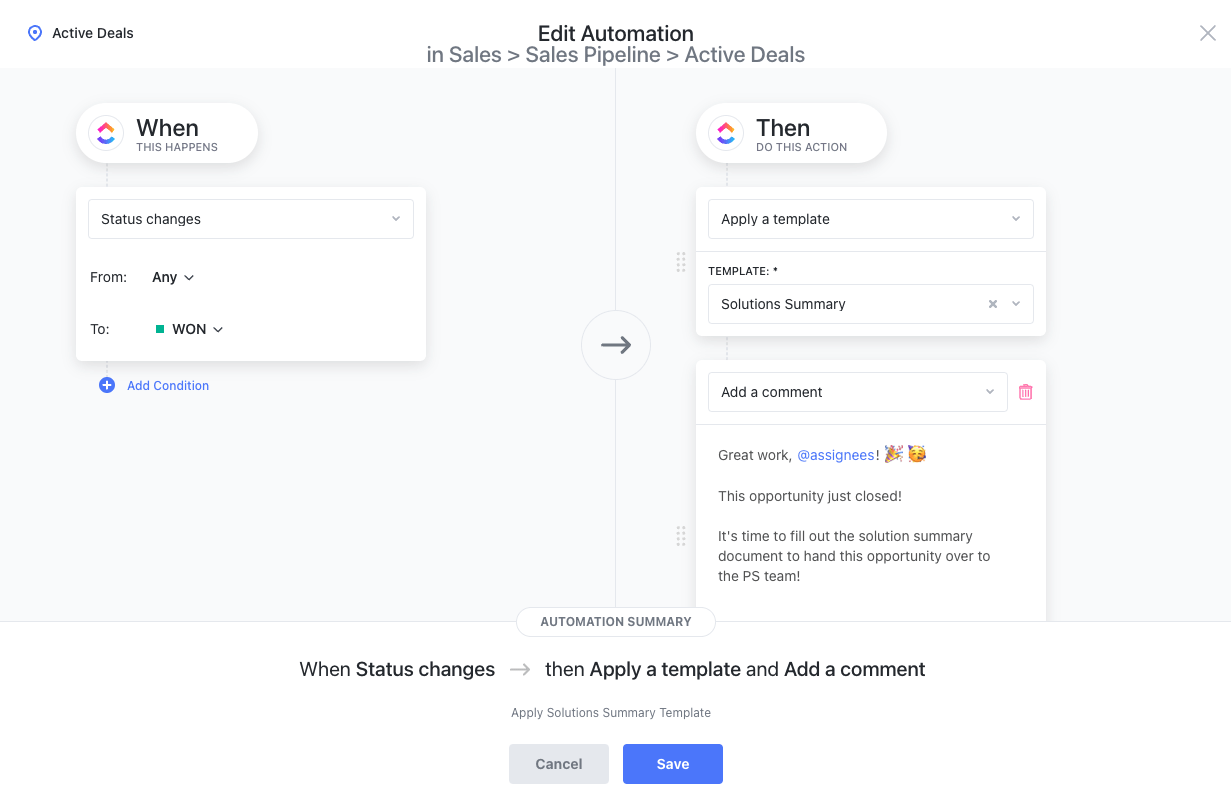
تُستخدم الأتمتة لتشغيل النتائج عند حدوث إجراء ما تلقائيًا. على سبيل المثال، باستخدام أتمتة "عندما تتغير الحالة"، نقوم بتطبيق قالب على مهمة ما لضمان عدم فقدان أي معلومات قيمة أثناء عمليات تسليم العميل
والخيار الثاني هو استخدام منصة أتمتة مثل جعل الذي يتيح لك تصميم أي شيء وإنشائه وأتمتة أي شيء في منصة مرئية واحدة.
إذا كان لديك مجموعة تطبيقات متنامية تعتمد على السحابة أولاً وترغب في توسيع نطاق استراتيجية الأتمتة الخاصة بك، فستجد في Make حلاً فريدًا قادرًا على التعامل مع أي نوع من العمليات.
تحسين سير العمل باستخدام أتمتة العمليات التجارية
أحد أكثر الأشياء المثيرة للاهتمام حول الأتمتة هو أنه، وفقًا لـ تقرير حالة SaaSOps لعام 2023 أن 7 من أصل 10 شركات قامت بالفعل بأتمتة عملية رئيسية واحدة على الأقل، وأن 4 من أصل 10 شركات لديها أدوار مخصصة للأتمتة.
وهذا يدل على أهمية أتمتة عمليات الأعمال: إنه ليس مجرد احتمال، أي أنه أمر يمكن أن يحدث أو لا يحدث.
بدلاً من ذلك، إنه شيء يتم نشره بالفعل في الشركات الرائدة هناك.
في ضوء ذلك ومدى سهولة استخدام أدوات الأتمتة في الوقت الحاضر، فإن الأمر مسألة وقت فقط حتى تبدأ كل شركة في التخلص من الأنشطة المملة والمتكررة والتحول إلى الأنشطة المنجزة لدفع أعمالها إلى الأمام وتقليل المخاطر الناجمة عن الخطأ البشري.
وأفضل طريقة لبدء هذه الجهود هي استخدام اثنين من أقوى برنامج أتمتة العمليات التجارية معًا انقر فوق و اصنع . باستخدام هذه الأدوات، ستتمكن بسهولة من إنشاء عمليات تجارية مؤتمتة بأقل قدر من التدخل والجهد البشري.
حان الوقت لتعزيز أعمالك بشكل فائق. ابدأ تحولك الرقمي باستخدام برنامج BPA اليوم - قم بأتمتة العمليات اليدوية إلى
العمل بشكل أسرع وأكثر ذكاءً
أكثر من أي وقت مضى. ⚡️
 ---
---
الكاتب الضيف:%

/ href/ https://www.linkedin.com/in/mrtnwrtr/?locale=en\\الولايات المتحدة الأمريكية مارتن إتشيغاراي /%/%href/
هو مدير محتوى ومحرر أول في Make. يستمتع بالقراءة والكتابة عن التاريخ والعلوم والتكنولوجيا. _
